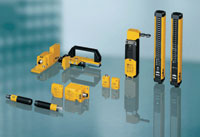
Posted to News on 20th Oct 2010, 00:00
Safer hand-fed platen presses
With the HSE about to commence on-site inspections of hand-fed platen presses, users of this high-risk machinery need to ensure that their presses meet the required safety standards. By working closely together, two companies have developed a novel, high integrity safety solution which uses an array of light beam sensors and a modular safety control and monitoring system.

A collaborative development project between two UK-based companies has resulted in a safer working environment for operators of a hand-fed platen (die cutting) press. Pilz Automation Technology and SCA Display UK - a manufacturer of Point-of-Display (POD) products for retail customers - worked together to improve the safety of a hand-fed platen press at SCA Display's production plant in Shenstone.
Most of the die cutting at SCA Display UK's Shenstone plant uses semi-automatic presses, but one of the presses is hand-fed, which is used for short runs and one-off customer specials. Ian Clews, Facilities Manager at Shenstone, says: "A typical hand fed platen press closes with a tremendous force, often with the operator's body in close proximity. This means that operator safety is critical."
In the UK, the HSE recently issued safety alerts to users of hand-fed platen presses. It is estimated that in the UK alone, there are between 1,000 and 2,000 such presses that require safety upgrades. Most of the high-risk machines fall into the 1.4-2m width range.
The HSE is currently considering issuing alerts to users in order to raise awareness of the potential dangers of whole body access between the platens of these machines when operating in the 'dwell' mode. The alerts are in response to two fatalities since 2008 in the UK, where operators were crushed between the platens as they intervened during normal production. In both cases, the hand-fed machine was being used in the dwell mode and the power to the platen was not isolated before the intervention occurred and so the safety devices fitted to the machine did not prevent the platens closing on the operator. "During the setting process, waste removal, replacement of lay stops or mis-feed retrieval, even with the most safety conscious operators may try to beat the dwell and climb onto the platen press bed or lean into the machine. Whilst between the fixed and moving platen beds the operator is not detected by any of the usual safety systems," explains Clews.
Safe system of work
According to the HSE, the latest hand-fed platen presses are much larger than their predecessors and many users now use the machine's dwell mode to either give them more production flexibility or to speed up the machine's output, as this mode can often double the speed of operation. On most hand-fed platen presses, climbing onto the platen from the normal operating position in front of the machine can be done without operating the safe edge that is normally fitted to the leading edge of the lower platen. This means that if a safe system of work is not followed, including isolating the machine, the platen may then continue to cycle if it is being used in the dwell mode and the protective devices will not automatically be triggered.
Further investigation by the HSE has showed that standards of guarding and working practices on many existing, larger hand-fed platen presses need to be improved significantly. So HSE announced that it would commence on-site inspections of hand-fed platen presses in October 2010. None of that surprises SCA Display UK, which last year decided to improve the safety of its hand-fed platen press at Shenstone. Clews contacted Pilz Automation Technology to discuss possible safety solutions. "By this time, I had already devised several concepts for upgrading the safety of the platen press, but needed to talk to a machinery safety specialist supplier about how the solution could be realised from a technological viewpoint. I also wanted the solution to be modular, enabling a best option for employee protection rather than a cost option."
The overall safety solution is based on Pilz's PNOZmulti modular safety system, with input and output expansion modules to control all aspects of machine safety and control. The light beam array detects a violation of the danger zone whilst the press is closing. This is achieved by sequentially muting the laser beams as the press closes. If any beam is broken before it has been muted, the press clutch safety valve is de-energised immediately bringing the hazardous movement to a stop.
Once the final beam has been broken (press closed) the beams remain muted until the press cam switch has operated, signalling that the press is at the 'home' position. The muting points are derived from the simulation of press position carried out within the PNOZmulti control system. The application also includes checking that the press cam switch operates correctly in each press cycle. "The project was completed successfully on the 16th of July and the press was handed over to our production team two weeks later," Clews concludes.









